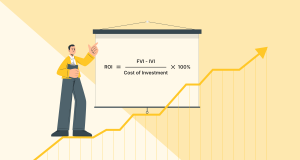Discover how to create winning business plans with solid financial forecasts. Get insights to drive sustainable success.
If you are one of the first-time entrepreneurs who just started your startup in recent months, the messages you get from everyone is: just focus on the MVP, try some ads, and get more users. Though critical, these are not where financial forecasting is typically concentrated. So a solid financial forecast can be the very weapon that allows startups to withstand the stormy early days and become successful in the long run.
Financial forecasting has a data-driven vision of the startup future. Making informed decisions, managing cash flow, attracting investors, and providing a roadmap that keeps the business on the right track concerning long-term goals. In this blog, we will be looking at how startups can use financial forecasting to keep winning, which method to use for forecasting, and some tips to get it right.
What Is Financial Forecasting?
Financial forecasting involves estimating or predicting a business’s future financial performance based on historical data, current trends and expected future events. For startups, that means forecasting revenue, expenses, cash flow, and profitability for a fixed period — usually 12 months to 5 years.
No forecast is ever 100% accurate, but the exercise should at least be useful. It gives you a chance to plan for various situations, utilise resources effectively and be ahead of possible issues.
The importance of financial forecasting for startups
Better Decision-Making
Financial forecasts enable startups to make informed decisions. Whether that’s how much to buy in inventory, when to hire or whether to scale operations, a solid forecast allows you to assess each option and its financial impact.
Cash Flow Management
Pretty much cash is king, if only for start-ups. A financial forecast allows you to keep track of how money comes into and out of your business, to ensure you don’t have liquidity problems later on. It can show you when you might run low on cash and let you plan ahead.
Investor Readiness
If you plan to raise capital, investors will expect a solid financial forecast. It shows you know your business, have attainable goals in mind and can be trusted to manage money responsibly. A comprehensive forecast can also help you defend your valuation.
Read More: What is Cash Flow Forecasting?
Targets and Goals And Performance Assessment
Forecasts provide you with quantifiable financial targets. As your business develops, you can reference actual results against your forecasts to see how well you’ve performed. This will assist in identifying the areas of improvement, and making short adjustments.
Strategic Planning
Once you have these projections crystal clear, you can build a roadmap for growth. Forecasts can tell you what revenue streams to emphasise, what products to develop, and what expenses to reduce or manage.
Key Components of a Startup Financial Forecast
Here are the key components of a full financial forecast for a startup:
Revenue Forecast
Estimate how much revenue your startup will generate as a starting point. Such factors could be pricing, sales volume, and market demand. If you’re an early-stage startup with no historical data, rely on industry benchmarks and market research to inform your assumptions.
Cost of Goods Sold (COGS)
If you have a product-based business, determine your cost of producing/obtaining those products. For startups that use a service model, this could be direct labor or software subscriptions.
Operating Expenses
Include foregoing costs like salaries, rent, marketing, legal, insurance, and other overheads. Break them down into fixed and variable expense types to know how your costs scale as you grow.
Cash Flow Projections
This is one of the most important things for startups. A cash flow forecast shows you when you’re going to receive money and when you’re going to pay bills. It guarantees you possess adequate liquidity to meet your short-term commitments.
P&L Statement (Profit & Loss Statement)
Also referred to as the income statement, this predicts your revenue, expenses and net income over a period of time. It provides an overview of profitability.
Balance Sheet Forecast
That does include your estimates for assets and liabilities and equity. It tells you what your business is worth at a specific point in time.
Read More: Financial Modeling for Small Businesses
Different Ways to Financially Forecast a Startup
Many different ways to create a forecast, two major ones used by startups:
Top-Down Forecasting
This technique begins with the market size and then calculates an estimate of your potential share of that market. Although this is helpful for a long-term vision, it can be too optimistic when not reasoned with realistic premises.
E.g.: “The worldwide food delivery market is $100B: If we capture 0.1% of this, that’s $100M revenue.
Bottom-Up Forecasting
This begins with the work you do every day in your business and builds from there. You might project units you can sell, at what price — then calculate your total revenue. This method generally leads to better accuracy and is friendlier toward the investor.
Example: “We’re able to fulfill 1,000 orders a month with a $15/order fee. That amounts to $15,000 in monthly revenue.”
How To Create An Effective Financial Forecast
Start Simple: You don’t have to build a fancy model on day 1. Get started with simple spreadsheets.
Use Realistic Assumptions: Don’t fall into the trap of overpainting an optimistically rosy picture. Ensure your assumptions are reality based. Set them according to industry benchmarks, expert interviews or pilot tests.
Scenario Planning: Always forecast for multiple scenarios: best case (BC), worst case (WC) and base case (BC). That trains you for volatility and provides you with a buffer for how you plan.
Review and Update Regularly: Forecasts are not a one-off document. Review it once a month or once a quarter, and adjust it according to what the actual results were. This keeps you nimble and responsive to the current state of affairs.
Invest in Tools: But as your startup scales, basic spreadsheets may not cut it. One option to automate and visualize your data is to use forecasting tools that take the manual work out of the process, such as LivePlan, QuickBooks or Float.
Use Cases of Financial Forecasting for Startups
For example, there may be a SaaS startup that was about to launch a project management tool. Before there was any development, the founders tried to estimate their growth using bottom-up forecasting:
- They assumed it would acquire 100 paying customers in the first six months.
- So which would pay $30/month per customer.
- By month six, monthly revenue would be $3,000.
- They had projected $1,000/month for marketing, and $15,000 upfront in development.
Their projection indicated they would breakeven in 12 months if growth continued. Using this, they managed to raise $50,000 in seed money by showing a clear route to profitability. The projection evolved into a living document, updated quarterly, informing decisions like how much to scale ad spend, when to launch new features, and when to time future fundraising rounds.
The startup now has more than 10,000 users, and still looks to financial forecasting to inform its strategy.
Common Pitfalls to Avoid
- Assuming Revenue: Hope is not a plan. Do not base your numbers only on the best-case scenario.
- Overlooking Expenses: Don’t overlook the hidden costs such as taxes, maintenance, software fees and payment processing fees.
- Not Involving the Team: Forecasting needs to be a participatory process with key team members. Your sales lead probably knows more about customer behavior than your spreadsheet.
- Not Reforecasting: One static forecast is not going to serve your business for years. Regular updates account for real world changes.
Final Thoughts
Financial forecasting can seem intimidating, but it is actually one of the strongest weapons in your arsenal as a startup founder to create a clear road to success. It’s not about 100% certainty in predicting the future, it’s in preparation, informed decisions and building credibility with stakeholders.
As your startup matures, your financial forecast is a dynamic compass. It tells you when it’s time to go faster, to slow down or pivot. So whether you’re scrappy on your way to the top or positioning to make the sale to investors, the bottom line is, put forecasting at the forefront of your startup strategy.
The choices you make today will shape your future. Use financial forecasting as the compass that points the way to long-term success.
![How Startups Can Leverage Financial Forecasting for Success [2025 Guide]](https://www.modelreef.io/wp-content/uploads/2025/04/Financial-Forecasting-for-Business-2.png)


